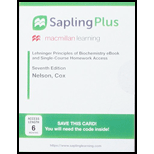
Concept explainers
To determine: The base sequence of the given complementary strand.
Introduction:
There are two types of nitrogenous bases: purines and pyrimidines. Adenine and guanine are the purine bases with double ring structures. Cytosine and thymine are the pyrimidines bases that have single ring structure. These bases pair with their complementary bases and form a
To determine: The special type of sequence which is contained in the DNA segment.
Introduction:
Some DNA segments have regions with inverted repeats which are in such way that an inverted and sequences which are self-complementary in a strand is repeated in the opposite direction in the complementary strand. This DNA segment is known as palindrome.
To determine: Whether the double-stranded DNA has the potential to form any alternative structures.
Introduction:
Some DNA sequences adopt unusual structures. The sequence dependent structural differences which are found in large chromosomes could affect the
Want to see the full answer?
Check out a sample textbook solution
Chapter 8 Solutions
SaplingPlus for Lehninger Principles of Biochemistry (Six-Month Access)
- 9. Which one of the compounds below is a major final product of the reaction sequence shown at the right? A) para-bromonitrobenzene C) meta-bromoaniline B) meta-bromonitrobenzene D) para-bromoaniline 1. HNO3, H2SO4 2. Br₂, FeBr3 3. H₂/Ni (3 atm) E) ortho-bromoanilinearrow_forward10. This reaction sequence includes an intramolecular Friedel-Crafts reaction. Which of the compounds below is expected to be the major product? PhCH2CH2CH2COOH 4-phenylbutanoic acid SOCI₂ AICI 3 A B C D Earrow_forward5. Which one is the major organic product obtained from the following reaction sequence? A B C OH i 1. NaBH4 CI 2. H₂O, H+ AICI 3 D OH Earrow_forward
- 1. Which one is the major organic product obtained from the reaction of toluene and cyclopentanol in the presence of H3PO4, as shown here? CH3 CH3 CH3 CH3 CH3 H3PO4 A B с D E OHarrow_forwardAscorbic acid is a diprotic, with ionizations of: pKa1 = 4.10; pKa2 =11.80. You need to make 350 mL of an ascorbate buffer that is pH 5.05, andyou have 1.5 mM stock solutions of :ascorbic acidmonosodium ascorbatedipotassium ascorbateHow much 1.5 mM monosodium ascorbate do you use to make yoursolution? Answer in mL and report your value to three signicant gures.Please type only the number.arrow_forward1. What is the abbreviated form of the name for the molecule below. Punctuate it correctly ( image attached) 2. How much ATP is formed by the complete oxidation of lignocerate? Show stepsarrow_forward
- fill in the blank and circle the active site for each molecule. urgent!arrow_forwardfill in the table and circle the active sitearrow_forwardThe two half reactions for beginning and end of the electron transport chain are given below in standard form. Calculate & for the overall process. Using the Nernst equation (AG° = -n Fo, F= 96.485 kJ/volt mol), calculate AG°. Explain the need for a stepwise process in the electron transport chain. NAD* + H+ + 2 e- = NADH ½ 0г + 2H+ + 2е- = H20 = -0.32v E = +0.82Varrow_forward
- answer the questions and the example steps should be from carbohydrates glycolysis and citric acid cycle. Please put down reactions and structuresarrow_forwardidentify the general type of reaction catalyzed and an example step from glycolisis structure for each of the following enzymes/ co factor Kinase, isomerase, mutase, dehydrogenase, NAD+ , FADarrow_forwardfill in the blanks with the missing structures and give namesarrow_forward
 BiochemistryBiochemistryISBN:9781319114671Author:Lubert Stryer, Jeremy M. Berg, John L. Tymoczko, Gregory J. Gatto Jr.Publisher:W. H. Freeman
BiochemistryBiochemistryISBN:9781319114671Author:Lubert Stryer, Jeremy M. Berg, John L. Tymoczko, Gregory J. Gatto Jr.Publisher:W. H. Freeman Lehninger Principles of BiochemistryBiochemistryISBN:9781464126116Author:David L. Nelson, Michael M. CoxPublisher:W. H. Freeman
Lehninger Principles of BiochemistryBiochemistryISBN:9781464126116Author:David L. Nelson, Michael M. CoxPublisher:W. H. Freeman Fundamentals of Biochemistry: Life at the Molecul...BiochemistryISBN:9781118918401Author:Donald Voet, Judith G. Voet, Charlotte W. PrattPublisher:WILEY
Fundamentals of Biochemistry: Life at the Molecul...BiochemistryISBN:9781118918401Author:Donald Voet, Judith G. Voet, Charlotte W. PrattPublisher:WILEY BiochemistryBiochemistryISBN:9781305961135Author:Mary K. Campbell, Shawn O. Farrell, Owen M. McDougalPublisher:Cengage Learning
BiochemistryBiochemistryISBN:9781305961135Author:Mary K. Campbell, Shawn O. Farrell, Owen M. McDougalPublisher:Cengage Learning BiochemistryBiochemistryISBN:9781305577206Author:Reginald H. Garrett, Charles M. GrishamPublisher:Cengage Learning
BiochemistryBiochemistryISBN:9781305577206Author:Reginald H. Garrett, Charles M. GrishamPublisher:Cengage Learning Fundamentals of General, Organic, and Biological ...BiochemistryISBN:9780134015187Author:John E. McMurry, David S. Ballantine, Carl A. Hoeger, Virginia E. PetersonPublisher:PEARSON
Fundamentals of General, Organic, and Biological ...BiochemistryISBN:9780134015187Author:John E. McMurry, David S. Ballantine, Carl A. Hoeger, Virginia E. PetersonPublisher:PEARSON





